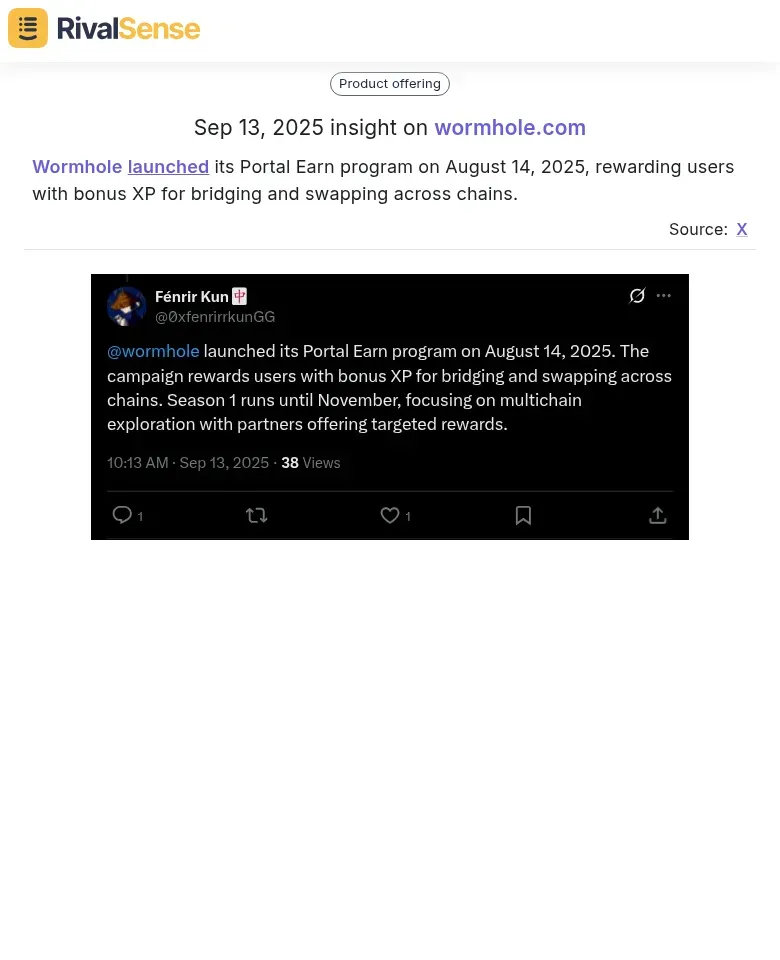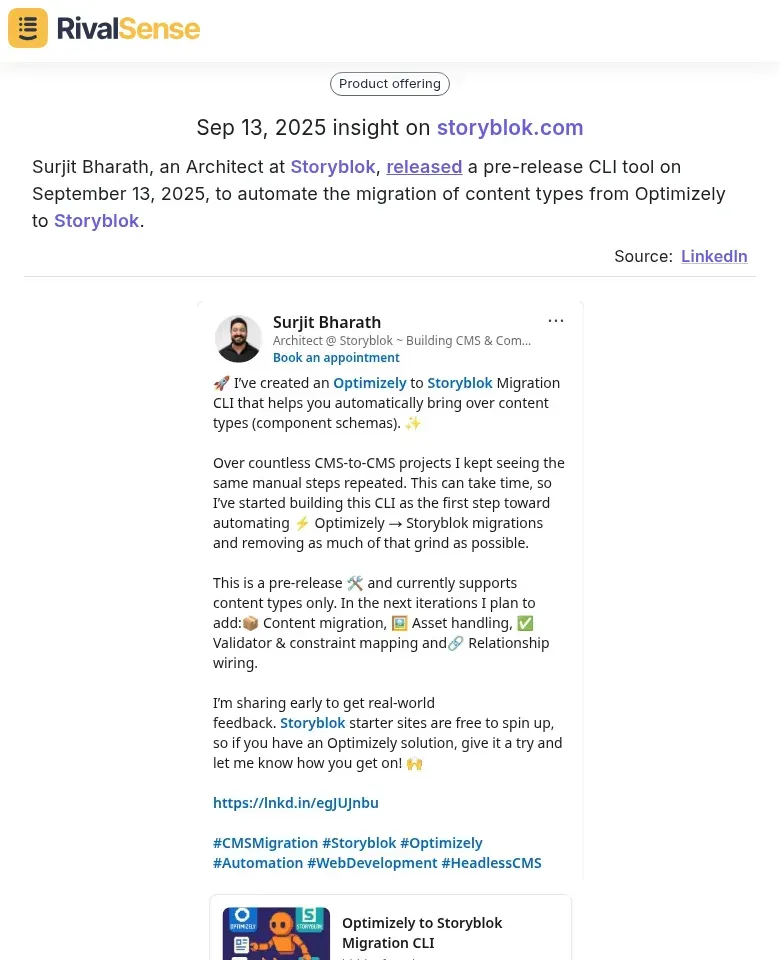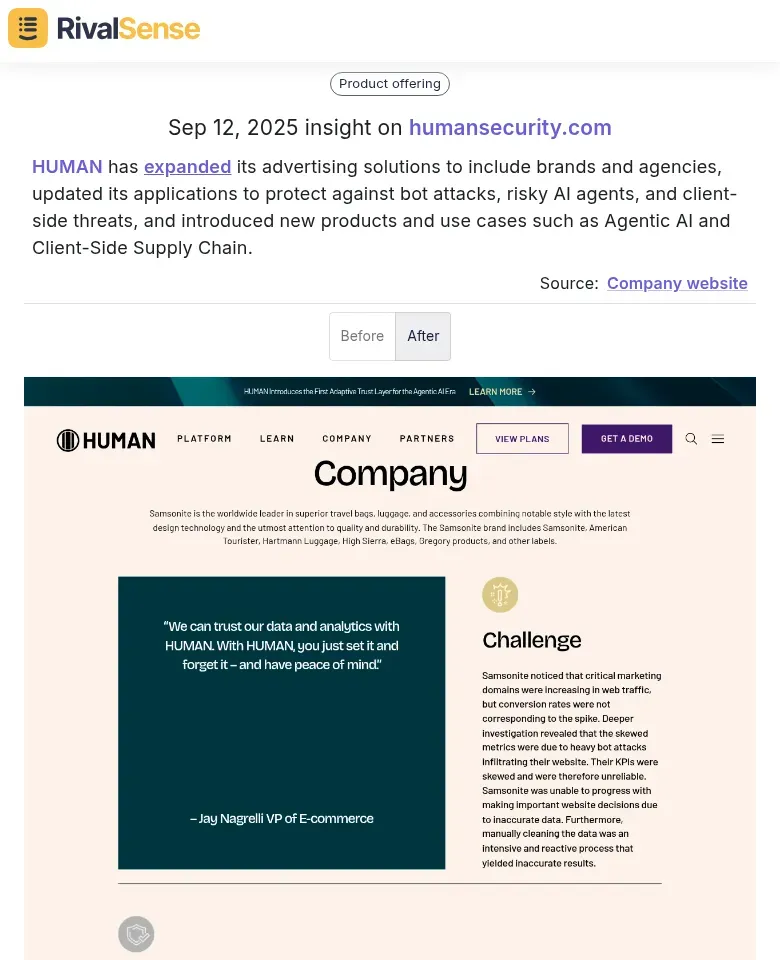Competitor Product Insights: A Key Account Growth Blueprint
In today's hyper-competitive B2B landscape, tracking competitor product launches isn't just about staying informed—it's about uncovering strategic opportunities for key account growth. When you monitor competitors' new offerings in real-time, you reveal market gaps they've overlooked and identify expansion opportunities within your existing accounts.
Consider this: McKinsey's 2024 B2B Pulse Survey shows that B2B customers now use an average of 10 interaction channels, and 65% of 'seeker' archetypes will switch suppliers if they don't get a seamless omnichannel experience. This creates immediate opportunities when competitors launch products that fail to address these evolving expectations.
Practical steps for leveraging competitor insights:
✅ Set up real-time alerts for competitor product announcements and feature updates
✅ Analyze customer reviews of competitor launches to identify unmet needs
✅ Map competitor offerings against your key accounts' pain points
✅ Develop rapid-response strategies to address gaps before competitors can iterate
Our blueprint approach will demonstrate how companies are using competitor intelligence to drive 20%+ account expansion by identifying where competitors fall short and positioning their solutions as the superior alternative.
Learning from Incentive Programs: The Portal Earn Model
The Portal Earn Model demonstrates how strategic incentive programs drive user engagement and cross-platform adoption. By offering tiered rewards for completing specific actions—like referrals, purchases, or consistent usage—you create a compelling reason for users to explore multiple features.
Real-World Example:
Wormhole launched its Portal Earn program on August 14, 2025, rewarding users with bonus XP for bridging and swapping across chains. This type of insight is valuable because it reveals how competitors are structuring engagement programs and can inspire your own retention strategies.

Timing is critical: launch incentive programs during peak user activity periods or alongside major product updates to capitalize on existing momentum. Align rewards with user behavior data—if analytics show high engagement on weekends, schedule bonus offers for Fridays to boost participation.
Practical steps to implement:
- Define clear objectives (e.g., increase referrals by 20%)
- Choose rewards that align with user preferences (discounts, exclusive access)
- Use a multi-tier system to encourage progression
- Communicate transparently about how to earn and redeem rewards
- Monitor metrics like redemption rates and user retention to optimize
Bonus systems enhance account stickiness by creating emotional investment—users who earn rewards are 3x more likely to remain loyal. Tip: Integrate social sharing features to turn rewards into viral growth tools, as seen with Dropbox's referral program that boosted sign-ups by 60%.
Migration Automation Insights: The Pre-Release CLI Tool Example
Migration automation tools are game-changers for winning key accounts from competitors. Technical tools that simplify transitions can reduce customer friction by 70% and create compelling reasons for prospects to switch from competing platforms.
Real-World Example:
Surjit Bharath, an Architect at Storyblok, released a pre-release CLI tool on September 13, 2025, to automate the migration of content types from Optimizely to Storyblok. Tracking such technical developments helps you understand how competitors are lowering barriers to entry and can inform your own product roadmap.

Practical Steps for Implementation:
- Develop migration tools that automate data extraction from competitor platforms
- Create pre-release testing programs with early adopters to refine migration strategies
- Implement validation checks to ensure data integrity during transfers
- Offer personalized migration support for enterprise accounts
Key Insights: Early adopter feedback revealed that automated migration reduced setup time from weeks to hours. The CLI tool's batch processing capability allowed enterprise clients to migrate thousands of records simultaneously, eliminating manual data entry errors. Technical teams should prioritize creating comprehensive documentation and video tutorials to support self-service migrations.
Pro Tip: Integrate migration analytics to track success rates and identify friction points. This data-driven approach helps continuously improve the migration experience and demonstrates ROI to potential customers considering switching from competitors.
Security and AI Expansion: Learning from HUMAN's Multi-Pronged Approach
HUMAN Security's strategic expansion demonstrates how integrating AI and security features drives account growth across new customer segments. By expanding from traditional enterprise clients to brands and agencies, HUMAN leveraged its core bot detection capabilities while adding AI-powered media security solutions.
Real-World Example:
HUMAN has expanded its advertising solutions to include brands and agencies, updated its applications to protect against bot attacks, risky AI agents, and client-side threats, and introduced new products and use cases such as Agentic AI and Client-Side Supply Chain. Monitoring such strategic expansions helps you anticipate market shifts and identify new competitive threats.

Key lessons for B2B leaders:
- Identify adjacent customer segments that can benefit from your core technology
- Integrate AI to enhance scale and efficacy of existing solutions
- Balance innovation with core competency expansion
- Secure funding specifically for platform expansion and AI integration
- Develop tiered partner programs to support new market entry
Practical checklist for similar expansion:
- [ ] Conduct market research on emerging threats in target segments
- [ ] Map core capabilities to new customer pain points
- [ ] Allocate dedicated resources for AI integration
- [ ] Create segmented pricing and packaging strategies
- [ ] Establish channel partnerships for market penetration
- [ ] Measure success through customer acquisition costs and lifetime value across segments
Implementing Competitor Insights: A Framework for Key Account Growth
Implementing a systematic competitor monitoring framework is essential for key account growth. Start by establishing automated tracking across competitor websites, social media, and regulatory filings to capture product developments, pricing changes, and customer engagements.
Translate insights into actionable strategies: Create account-specific battle cards highlighting competitor vulnerabilities, conduct quarterly SWOT analyses for top accounts, and train sales teams on positioning against specific rivals. Monitor competitor churn patterns and contract renewals to identify conversion opportunities.
Measure impact through KPIs:
| Metric | Target Improvement |
|---|---|
| Competitive win rate | 15-20% improvement |
| Key account conversion velocity | 25-30% reduction |
| Customer acquisition cost | Significant reduction |
Use a weighted ROI formula: 40% revenue impact, 30% risk reduction, 30% efficiency gains. Establish monthly review cadences to ensure strategies remain agile and data-driven.
Conclusion: Turning Competitor Intelligence into Sustainable Account Growth
The key account growth blueprint demonstrates that sustainable growth requires a competitor-aware strategy. Key takeaways: implement continuous monitoring to track competitor pricing, product launches, and messaging shifts in real-time. Establish automated alerts for competitor website changes, social media campaigns, and customer reviews to identify opportunities before they're obvious.
In dynamic B2B markets, continuous monitoring is non-negotiable. Set up weekly competitor intelligence briefings and monthly deep-dive analyses. Use advanced tools to analyze competitor content themes, engagement patterns, and customer sentiment shifts.
Next steps for implementation:
- Create a competitor intelligence dashboard with key metrics
- Develop response protocols for common competitor moves
- Train account teams on leveraging competitor insights during client conversations
- Establish quarterly competitive positioning reviews to adjust strategies based on market movements
Remember: competitor intelligence isn't about copying—it's about finding gaps and opportunities your competitors are missing.
Ready to transform your competitor intelligence? Try RivalSense for free and get your first competitor report today. Track product launches, pricing updates, partnerships, and more—delivered in a comprehensive weekly email that keeps you ahead of the competition.
📚 Read more
👉 Analyzing Competitor Partnerships: A Case Study with ABC Legal and CT Corporation
👉 Competitor Webinar Analysis: Turn Intelligence into Strategic Advantage
👉 Predictive Key Account Tracking: How Semiconductor Design Leaders Stay Ahead
👉 How Real-Time Executive Intelligence Secured a Competitive Hiring Advantage
👉 Predict Competitor Wins: LinkedIn Insights Reveal Why Customers Choose Rivals
